In my last culinary school update for this series, I wrote about making Peking ducks, the most memorable project our class has undertaken so far. The heart of our culinary program, though, lies not in our afternoon classes but our morning labs. From 7 a.m. until at least 11 a.m., we students sleepily shuffle in to prepare for the school’s breakfast and lunch service. We’re divided into small groups each semester that focus on a specific area of food preparation; in some labs, students focus on a single area for the entire semester, and in others, they switch focus halfway through.
Second-year students take turns writing each week’s menus. Then, they must translate these menus into daily production sheets that are distributed to the lab groups first thing each morning. These sheets tell us first-years what to make and in what quantity and also include recipes or specific instructions. In addition to the daily menu, most weeks include themed buffets planned by students in the Buffet/Garde Manger course. Two of this semester’s highlights included a Cajun buffet featuring gumbo and pecan pie, and an Asian breakfast buffet serving fried rice flour balls in coconut syrup and okonomiyaki (savory Japanese pancakes). I enjoy that the buffets provide us with such variety in food preparation experience, and I sneak my fair share of tastes. Students also often share their heritages with the school by preparing their favorite family recipes. I remember one week when a student shared her love of bacon. Everything on our menu seemed to include bacon, and we literally ran out of sheet pans, as each was being used to cook bacon.
Besides the themed buffets, students’ personalities shine in other parts of the daily menu. Each lunch includes two different types of dessert, a cold sandwich, a salad, a soup, a blue plate special, and a hot sandwich that can range from homemade calzones to pulled pork sandwiches on homemade onion buns. Blue-plate specials include a protein, vegetable, starch, and baked good, giving every lab practice at making something new each day. I’m envious of Minnesota State students and faculty who get to feast on $5 plates of smoked pork ribs or medium-rare steaks – a far cry from blue plate specials of previously frozen-fried fish fillet sandwiches served with a side of corn chips and nacho cheese sauce. I hope they realize how fortunate they are.
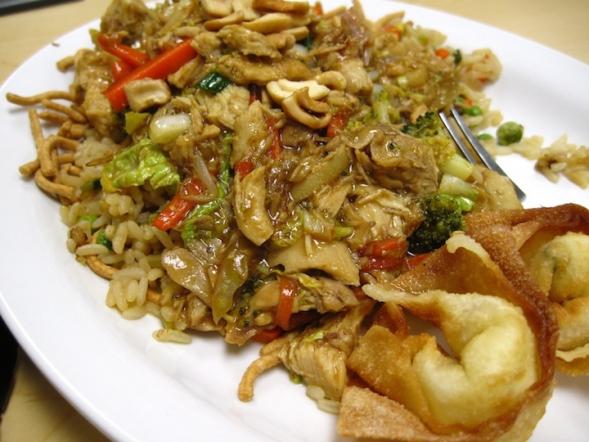 A typical Blue Plate Special:
A typical Blue Plate Special:
Chicken-cashew stir fry with chow mein noodles, fried rice, and cream cheese wontons
Since beginning culinary school, I’ve completed the salad, baking, and quantity labs, and, like everyone else, I have my favorites and least favorites. I liked salad lab the least, which also happened to be my first lab, serving as a rough introduction to culinary school. The first weeks of salad lab were a true test of patience. Our production sheets didn’t offer enough work to keep everyone busy with their own project, so we arrived as early as possible to stake a claim on an assignment. We doubled, even tripled up on items as simple as making a chicken salad or assembling a sandwich. At its worst, one person would place the meat and cheese on the wrap. The next would swipe it with mayo. The third would roll it up like a burrito. A fourth cut the sandwich, a fifth added the vegetable garnish, and finally, the sixth wrapped the plate in plastic wrap.
Usually, we play nice with each other, but I remember one particularly frustrating morning in which a student arrived early to claim a sandwich wrap. By the time she was ready to assemble her components, the rest of us were finished with our assignments. We extended offers to help her finish the sandwiches, but she declined, preferring to make them by herself, leaving us stuck in limbo between having no projects to work on and wanting to stick around for clean up. The student took her time making each wrap, spending minutes on each one, and 40 sandwiches seemed like eternity. I called a mutiny in the dish room.
Eventually, though, patience paid off for the faithful school attendees, and before I knew it, students began to drop out of the program for various reasons. We who remained became busy every morning. Just as in the real work world, working with others who demonstrate strong work ethics can make or break a semester. My most recent experience in Quantity Lab was no exception. By the second semester, our lab was down to four people. Our daily production sheets included two soups, one broth-based and one creamy, taco meat and fried tortilla bowls, a starch such as potatoes or rice, steamed vegetables, and sauce. If there was a meat entrée for the blue plate special, we’d also have a hand in its final cooking processes. On days when the production sheet was full and, most especially when someone did not make it to class, the morning felt like a marathon. Everything for a day’s lunch service has to be ready to serve by 11 a.m., just like as in a real restaurant. There are really no exceptions made and nary a soul is let off the hook. I like the challenge of working as efficiently (and safety) as possible and being held accountable for presentation and taste.
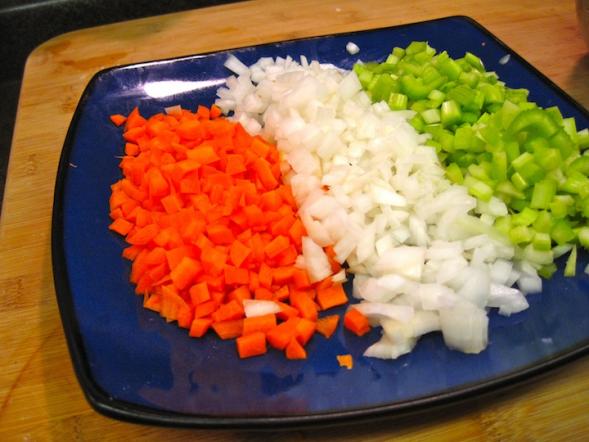 Vegetables prepped for soup
Vegetables prepped for soup
Everyone in Quantity Lab
enjoys making soups the best – the first two students who arrive in the morning
inevitably scribble their names next to the daily soups, staking their claim.
Sometimes I suspect students arrive early just to sign up for soups – I know I
have. Soups are also fun to make because they are hard to ruin. They can be
made by eyeballing ingredients instead of exactly measuring
them, and students
can add their personal touches as long as they don’t get too crazy. Soup making
also provides the variety since they change daily and involve the most slicing
and dicing. On days when I am lucky enough to claim a soup, I find immense
satisfaction from gathering vegetables into a big metal bowl and systematically
breaking them down into uniform pieces. You don’t need to work at a restaurant
or culinary school to improve your knife skills. It’s all about practice, which
you can gain it in your own kitchen by experimenting with different knife cuts
and challenging yourself to work (safely!) with increasing speed. As silly as
it sounds, I owe my better-than-average knife skills to practicing what I’ve
observed on food television.
It may not come as a surprise when I say that the creamy soups and chili seem to sell better than the broth-based soups. Creamy, cheesy soups sell the best. Some are so filled with butter, cream, and cheese that they make me blush. Cheeseburger soup is a perpetual favorite, gracing menus on a somewhat weekly basis. I have never had the stomach to eat a bowl of this soup, but I shouldn’t judge something before I try it. But one particularly cheesy creation – a Philly cheese steak soup – took the cake. I helped a classmate grate cup after cup of cheese, and in the end, we added at least three different types of cheese, plus slabs of that American cheese that melts so nicely. I think the recipe also included a heavy dose of cream and sautéed steak tips, so it is not wonder that it became one of the most requested recipes. Of course, it tasted sinfully wonderful, especially to those who like to eat queso dip.
Those who come to class last never get to make soup and are often relegated to potato duty. Classic baked potatoes, twice baked potatoes, mashed potatoes, roasted potatoes, and potatoes au gratin, I’ve made them all at least once in large quantities. I spent many mornings at the sink scrubbing bus tubs of potatoes, silently cursing myself for not getting up fifteen minutes earlier. Baked potatoes are the easiest to make. I diligently scrubbed them with a rag, I poked them with a fork to prevent them from exploding during baking, brushed them lightly with olive oil, and sprinkled them with course salt and maybe cracked black pepper. After spending about an hour in a 375-degree oven, we served perfect baked potatoes with creamy interiors and salty, crinkled skin. Growing up, my family made baked potatoes by microwaving them. I remember what a treat it was to eat real baked potatoes at restaurants, but you don’t have to dine at restaurants to eat these crispy skinned potatoes. Simply bake them on a sheet pan or place them directly on your oven’s shelves, but never wrap them in foil unless you want a steamed potato with soggy skin.
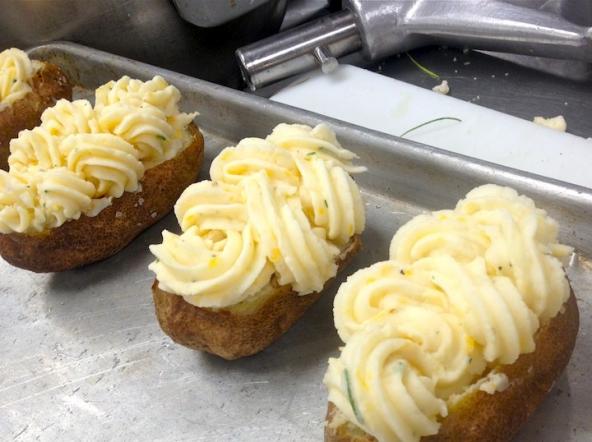 Twice-baked potatoes before baking
Twice-baked potatoes before baking
My favorite experience in Quantity Lab occurred when I got to make knoephla soup for the first time. Knoephla soup to North Dakotans is like chicken and wild rice soup is to Minnesotans. At some point during the week, nearly every restaurant and cafe in Fargo-Moorhead serves knoephla soup, a food tradition of the early Germans from Russia who settled on the North Dakotan plains. The best version of knoephla I’ve ever tasted was from the tiny Home Plate Café in Fredonia, ND, a town in the south central part of the state whose population was last recorded at 45. I was hypnotized by the glorious shimmer of butter that floated at the surface.
But while the Home Plate Café’s knoephla is the best, the version I made in class tasted better than those I’ve eaten around Fargo, mostly, I think, because I didn’t use cheap chicken base or bouillon and added homemade dumplings. Knoephla dumplings can easily be found at most major grocery stores in Fargo-Moorhead, but are more difficult to find in the Twin Cities. I’ve heard the frozen dumplings remain light and fluffy, but I prefer smaller, handmade dumplings even if they have a tendency to be less perfect. We don’t always have homemade chicken stock on hand, and I wouldn’t expect the average home cook to either. Boxes of chicken stock are expensive, so I’m fine with using a high quality chicken base in a pinch. Just make sure to examine the ingredient lists closely, as chicken should be the first ingredient, not MSG or salt. Choose an organic base if you’d like and look for ones that need to be refrigerated.
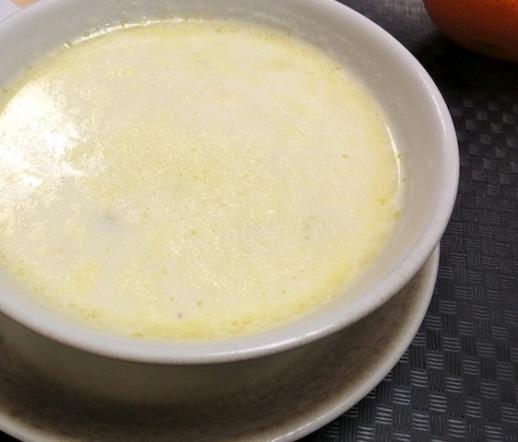 Knoephla Soup
Knoephla Soup
Knoephla Soup
The recipe makes a large pot of soup. Feel free to reduce the proportions for a smaller amount. I like to include more vegetables, so I added less liquid for a chunkier version and halved the dumpling mix. Don’t knead the dumpling mix for too long and note that they might become firmer the longer they simmer.
The versions I’ve tasted have included little seasoning besides the chicken broth and onions, but I don’t see how a handful of fresh herbs could hurt. Add chicken or don’t add chicken. Like any other soup, knoephla is versatile and forgiving. You probably won’t ruin it.
Ingredients:
- ¼ cup butter
- 1 onion, diced
- 2 stalks celery, diced
- 2 large carrots, diced
- About 2 cups waxy potatoes (red, gold) diced
- 1 gallon chicken stock
- 5 cups heavy cream (can use less)
- (optional) Cooked chicken meat cut or pulled into bite-sized pieces
- Salt
- White pepper
- Dash or two of sugar
Roux Ingredients:
About equal parts of:
- Butter or margarine
- Flour
Roux Instructions:
- Melt a stick of butter in a small pan.
- When it sizzles, gradually sprinkle in flour, whisking constantly to prevent lumps from forming.
- Try to coat each grain of flour with the melted fat as you whisk, stopping when the roux forms the texture of wet sand.
- Cook the roux until the flour loses its raw quality and remove from heat.
- This white roux will be perfect for light colored soups, sauces, and gravies. Cooking the roux until it turns brown will create a toastier flavor.
- Save extra roux in the refrigerator for quite some time. At school, we make large batches of roux with margarine since it’s less expensive and keep it on the counter for the week.
Dumpling Ingredients:
- 2 cups flour
- 1 tsp. baking powder
- 1 tsp. salt
- 2 eggs
- ½ cup cold water
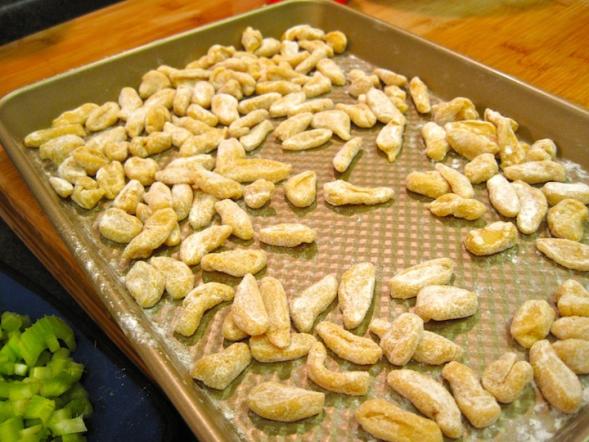 Knoephla dumplings cut, floured, and ready to be placed into the soup
Knoephla dumplings cut, floured, and ready to be placed into the soupDumpling Instructions:
- In a large bowl, scramble eggs. Combine with salt, baking powder, and water.
- Gradually mix in the flour. Stop when the dough forms a ball. Knead the dough until smooth. Its texture should be a little softer than pasta dough and feel stickier. Let the dough rest while you prepare the rest of the soup.
- Roll the dough into thin ropes. Cut into small pieces and place on a baking sheet. Lightly dust with flour so they don’t stick together. Keep the dumplings small, as they will expand when you drop them into the hot soup.
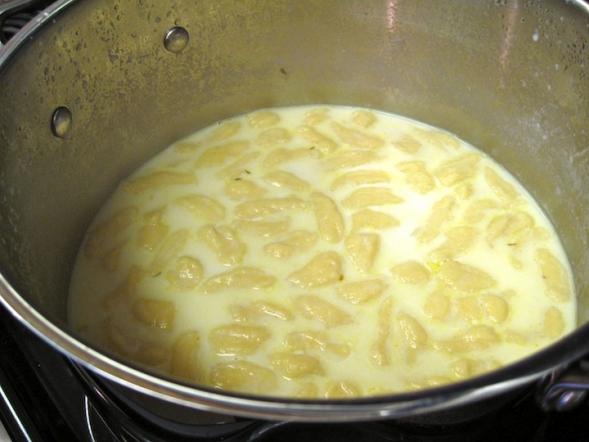 Knoephla dumplings added to soup
Knoephla dumplings added to soup
Soup Instructions:
- In a large soup pot, melt the butter.
- Cook the vegetables until tender.
- Add chicken stock and potatoes. Bring to a simmer.
- When the potatoes are tender, add the knoephla dumpling dough.
- Simmer until the knoephla dumplings are cooked through. Add heavy cream and chicken.
- To thicken the soup, whisk roux into hot soup, a little at a time. The roux will thicken the soup as it simmers. If you keep adding roux without giving the soup time to thicken, you may end up with paste.

Jeni Hill grew up in the Twin Cities and recently moved to Fargo. Her two sustaining passions are food and writing and she combines the two whenever she gets the chance. Jeni believes food is never just about the food and considers it the finest medium to connect with others. When she is not crafting contributions to Simple Good & Tasty, she may be posting to her blog An Herbalist Eats, 20food, or Fargo's High Plains Reader. Her last series for SGT was Farm to Fork, a CSA Series.

